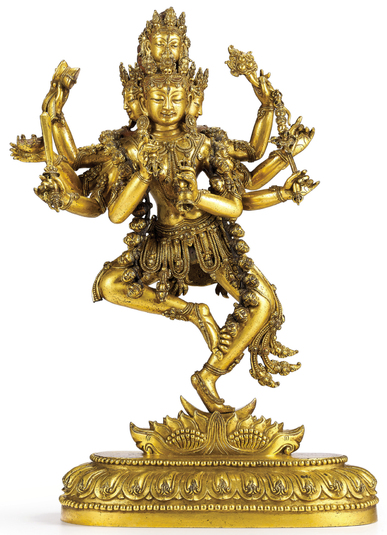
Item: Tara (Buddhist Deity) - Pitishvari Uddiyana
| Origin Location | China |
|---|---|
| Date Range | 1400 - 1499 |
| Lineages | Buddhist |
| Material | Metal, Mercuric Gild |
| Collection | Private |
Classification: Deity
Appearance: Wrathful
Gender: Female
Pitishvari Uddiyana Tara. An inscription in Chinese dates the creation of the sculpture to the Xuande Period, 1425 to 1435.
'Above a lotus and moon from the [letter] HUM is a protection wheel. Inside of that from E at the center of a dharmakara, from PAM, is a red lotus. In the middle from RAM is a sun [disc]. Above that from TAM is a red utpala marked with the letter TAM radiating and absorbing light. [From that] I arise as Revered Arya Tara, red in colour, with four faces and eight arms. The main face is red, right black, left green, above yellow, [each with] three eyes. The right hands hold a damaru drum, skullcup filled with blood, sword and vajra [scepter]. The left hands [hold] an utpala, jewel, katvanga and a bell. The left leg is extended in a dancing manner. Adorned with a crown of skulls, necklace of fresh heads, and the five mudras; wearing a tiger skin skirt, smiling and feirce, with yellow hair flowing upward, standing in the middle of a mass of fire.' (Taranata, Rinjung Gyatsa, volume 1, page 293).
This form of Tara stands on top of a large red utpala flower rising out of dharmakara (tetrahedron with three sides closed and the top open).
The text above is an abbreviated version of the main Tibetan source text composed by Chogyal Pagpa Lodro Gyaltsen (1235-1280 [P1048]) in the Fire Female Rabbit year, 1267/68, in the 9th month 15th day to the 10th month 15th day, at a place known as Kang Gya. (See Sakya Kabum, Chogyal Pagpa, volume 2, folio 287-291).
Lineage Teachers: Tara, Dakini Vajrasana, mahasiddha Saraha, Vinatabhadra, Sanghamashri, Lilavajra, Lotsawa Shakya Dorje, Ngonpawa, Wangchug Tsundru, Pagpa Rinpoche, Chang Taglungpa Mangalguru, Ratna Guru, Ratna Kara, Tashi Paltseg, Ngagwang Dragpa, Tsultrim Chodrub, Namgyal Tashi, Je Namgyal Puntsog, Jonang Taranata, etc. (Volume 2, page 283).
As can be seen from the lineage, Taranata acquired the tradition of Uddiyana Tara from a rather circuitous route. Pagpa Rinpoche refers to the Sakya Patriarch Chogyal Pagpa. Shortly thereafter the lineage entered the Taglungpa line and then meanders back out and eventually to Jonang Taranata in the late 16th early 17th century.
***Correction*** This sculpture was previously identified and published in Hong Kong, Sothebys, 8th of April 2010, incorrectly as a form of Vajrayogini. Upon further investigation and the text reference above it is now correctly identified as a form of Tara as per the writings of Chogyal Pagpa (1235-1280 [P1048]) and Jonang Taranata (1575-1635 [TBRC P1428])
Jeff Watt [updated 9-2017]
Subject: Masterworks Main Page (大师之作主页, ཕུལ་བྱུང་གི་སྒྱུ་རྩལ་ཁག།)
Thematic Sets
HAR: Question & Answer Webinar
Buddhist Deity: Tara Religious Context
Sculpture: Three Topics Outline
Buddhist Deity: Tara, Red (All Forms)
Buddhist Deity: Tara, Red (Masterworks)
Buddhist Deity: Tara, Wrathful (Various Forms)
Collection: Sotheby's Hong Kong (Painting & Sculpture. October, 2017)
Iconography: Buddhist Appearance (Figurative Forms)
Buddhist Deity: Tara, Sculpture (Masterworks, Miscellaneous)
Buddhist Deity: Tara (Uddiyana)
Subject: Masterworks (Female Deity, 女性尊神, ལྷ་མོའི་ཚོགས།)
Buddhist Deity: Deities (Yongle)
Sculpture: Yongle Style, Xuande & Zhengtong Period
Buddhist Deity: Tara (Miscellaneous Iconography Masterworks)
Sculpture: Yongle & Xuande Style (Masterworks)

